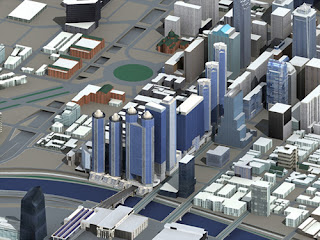While the corporate trainwreck that redefined city skylines across the world grinds into second gear (kind of like the theme from Friends for urban development), public projects have become too numerous to keeptrack. From Race Street to University City to Manayunk, one could easily question, "Where is all this money coming from?" We left the definition of the city up to private developers in the 90s and early twenty-first century, but now, inexplicably, the city seems to be doing the work itself.
UCD's 30th Street Station Plaza will officially open on November 2nd, just before Dilworth Plaza's renovations are expected to begin. Overnight we seemed to welcome more miles of bike lanes than Seattle and Portland combined, and the Reading Terminal Viaduct Park almost seems like it might be more than the idealistic dream of the hipsters that can't afford to live there.
30th Street Station Plaza
The Parkway is being redefined as America's Champs-Élysées with enough artwork to make those dining on its Parisian counterpart choke on their baguettes in jealousy, the Schuylkill River Trail is being expended into territory that hasn't been explored since South Philadelphia was home to natives, and perhaps more shocking than anything, Philadelphians are actually exploring the Delaware River...recreationally!
Greening JFK
As national news syndicates continue to run headlines about our grim economy, without the cranes and scaffolding of progress, Philadelphia appears to steaming forward without hesitation. Perhaps we owe our lowered expectations, those fostered by the shadows of New York City, more credit than they often receive. There is no doubt that these public projects are taking place around the country, often funded with federal stimulus money, but in a city accustomed to leaning on private corporations to pick up the tab for civic inefficiencies, it is almost heartwarming to see our money at work.
 In spite of a bad economy, it's evident that Center City is still looking for tenants. And while Carl Dranoff's soap opera sets won't earn a place next to the PSFS tower, he's filling the voids on South Broad Street, a place with no right to the vacant lots it owns.
In spite of a bad economy, it's evident that Center City is still looking for tenants. And while Carl Dranoff's soap opera sets won't earn a place next to the PSFS tower, he's filling the voids on South Broad Street, a place with no right to the vacant lots it owns.










